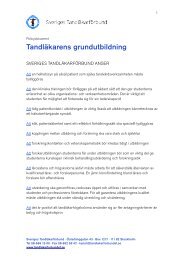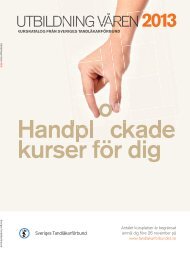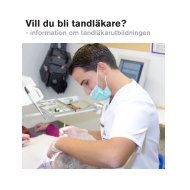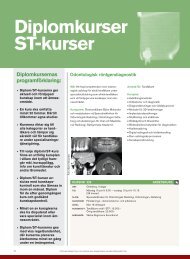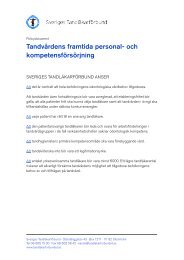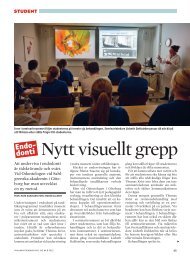Swedish Dental Journal
Swedish Dental Journal
Swedish Dental Journal
Create successful ePaper yourself
Turn your PDF publications into a flip-book with our unique Google optimized e-Paper software.
eth and progressive attachment and bone loss”(21),<br />
at least one finding providing soft tissue inflammation,<br />
and one providing loss of supporting tissue<br />
should be used, for example bleeding and bone loss.<br />
Furthermore to be chronic there should be a loss of<br />
supporting tissue over time (20). Until date, no exact<br />
definition exists and very few of the clinicians in this<br />
study comments that there should be a loss of supporting<br />
tissue over time.<br />
In all categories there were clinicians that used<br />
irrelevant findings, i.e. findings not mentioned in<br />
any study or classification to be a finding used to<br />
diagnose chronic periodontitis. Such findings were<br />
for example plaque and calculus. These findings<br />
are considered to be irrelevant since they do not,<br />
per se, describe the disease. Plaque and calculus are<br />
findings that could be present both in patients with<br />
and without periodontitis (3). Even though the dental<br />
hygienist students were in the majority when it<br />
comes to the use of irrelevant findings, both dental<br />
students and supervisors used such findings. The<br />
teachers used few irrelevant findings and were found<br />
to be more evidence-based but the students were not<br />
in compliance with their teachers. Only one dental<br />
teacher used tooth mobility as an irrelevant finding.<br />
None of the supervisors in the <strong>Dental</strong> Public Health<br />
used attachment loss as a finding when they diagnosed<br />
chronic periodontitis. This was expected since<br />
attachment loss as a measurement of loss of supporting<br />
tissue is hard to perform in daily praxis and<br />
is also time-consuming, and hence, more often used<br />
in research projects. The supervisors in contrast to<br />
the dental teachers have sparse experience of performing<br />
research.<br />
The reasons why dental hygienist students differed<br />
could, according to our experience, depend on<br />
their educational training and the traditional image<br />
of their future work, which mainly consists of prophylactic<br />
treatment, supporting treatment and treatment<br />
of the disease per se, including removal of<br />
the biofilm with bacteria and calculus. The clinical<br />
experience and knowledge of the teachers could also<br />
be an explanation as to why there are differences<br />
between students. The majority of the teachers at<br />
the dental hygienist education are dental hygienists<br />
while they are all dentists at the dentist education.<br />
Conclusions from this study are:<br />
• Variations were found between what findings<br />
different categories of clinicians used when they<br />
diagnose chronic periodontitis.<br />
• <strong>Dental</strong> hygienists students used a significantly<br />
leisnert, hallström, knutsson<br />
higher number of findings (P




